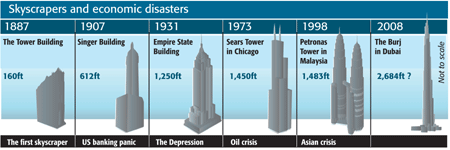
In 1999, Andrew Lawrence, then of Dresdner Kleinwort Benson, created his skyscraper index. He suspected that construction of the world’s tallest buildings coincided with the business cycle – and he was right.
The indicator was “nearly perfect”, showing “an unhealthy 100-year correlation”, suggesting that the construction of ever-taller buildings was a good warning sign of a looming economic slowdown.
So with Moscow the latest city to unveil plans to build the world’s tallest building, at a time when fear of recession is gripping the US and, increasingly, the UK, perhaps we should take a new look at this idea.
Bradford Lee Gilbert designed and built the very first so-called skyscraper in 1887 as a way of tackling a client’s unusually shaped six-and-a-half metre plot on Broadway in New York. The solution was to build an iron bridge truss, but stand it on end so that the real structure of the building started several storeys above the kerb – producing the best design to maximise occupancy and rentals. New York’s press ridiculed the idea. Fellow architects pronounced the building unsafe. Building experts said it would blow over in the wind, if it ever got off the ground. New Yorkers themselves were aghast at the notion of a building that would tower above their side-walk to a height of 160 feet. A fellow engineer and friend begged Gilbert to abandon the idea, pointing out that if the building really did fall over, his legal bill would ruin him. Lawyers confirmed this, but Gilbert knew better, arguing that the building’s structure, with wind bracings from top to bottom, meant that the harder the wind blew, the safer it would actually become. To put the matter to rest Gilbert requested the top two floors of the new building for his offices.
The rest, of course, is history. Since then, successively taller buildings have come in waves – the most infamous being the Empire State Building, which opened for business in May of 1931 to great fanfare, but was practically empty. This is hardly surprising: as any decent architect could tell you (although economists these days seem strangely unaware of the fact), tall buildings are just built to make the land pay. As a general rule, a skyscraper is a speculative project, built mostly by developers with other people’s money. Such buildings will only be built when credit conditions are easing, or at their easiest – in other words, when developers are most flush with funds.
So what will happen this cycle? Already, the construction of more record-breaking buildings is coinciding with the end of yet another 18-year real estate cycle, just as has happened in every cycle since 1837 (for more on the 18-year property cycle, see: Is the global property market about to crash?). It can also be seen that the geographic location of the tallest buildings usually experiences the severest slump in the years after the general downturn. This does not bode well for Shanghai or Dubai. In Shanghai, the 101-storey Shanghai Tower is due to open in spring this year, being built by Minoru Mori. While he is a rich man, a lot of debt – $7.2bn – is financing his ambition.
As for what is happening in Dubai, we know that development is proceeding at breakneck speed. While it’s not easy to come by information on what is happening there, a decent amount of debt and leverage is certain. It remains to be seen how a real-estate downturn in the rest of the world will play out there – but the omens aren’t good. The Burj (tower) under construction in Dubai was officially classed as the tallest building in the world on 21 July 2007 – the very day of the stockmarket high in New York, from which all the recent credit troubles have cascaded. An unhealthy correlation indeed.
Phil Anderson is managing director of Economic Indicator Services, an economic forecasting service based in London.